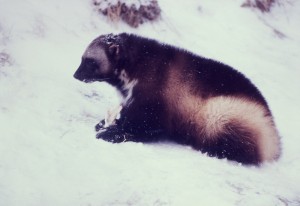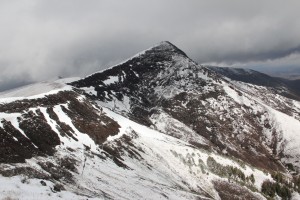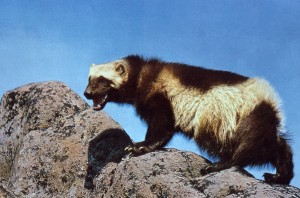The recent announcement that federal officials have proposed Endangered Species Act protections for Gulo gulo was big news for all of us who revere the most audacious and least understood of the charismatic carnivores in the Yellowstone ecosystem. Maxing out around 40 pounds, the wolverine has been known to face off with grizzly bears over carrion in the wilds of Yellowstone and NW Montana. With an estimated 250-300 animals left in the lower 48 states, this listing as a Threatened Species under the Endangered Species Act is much deserved, long overdue and addresses a loss of core habitat, the impact of climate change on this high mountain, snow dependent species and the heinous fact that Montana (the only state in the contiguous United States to do so) still allows trapping of this remarkable species in decline. In 2008, the first documented wolverine sighting in Northern California since the 1920s occurred, most likely a wanderer from the North Cascades, more than 900 miles to the north—a testament to the spirit of a species needing to expand its range.
According to a Yellowstone Park Foundation study of the wolverine population in the eastern portion of the Greater Yellowstone area that was conducted from 2005-2009, far fewer wolverines were documented than expected. While the rugged terrain of the Absaroka Range north and east of Gardiner, Montana, along with the remote recesses of the Thoroughfare region south and east of Yellowstone proved the most important habitats for wolverines in this study, researchers documented ample habitat suitable to wolverines that simply wasn’t being occupied.
The summary of the afore-mentioned study from WolverineNetwork.org accentuates the importance of protecting this species in decline. “This eastern GYA study drives home just how hard it is to study this rare and elusive alpine carnivore. The researchers logged a total of 5,248 trap nights, which is equivalent in effort to putting out a single trap every day, all year long, for more than fourteen years! This amazing amount of effort yielded just seven captures of four unique individual wolverines. Again, if put in terms of a single trap open and maintained yearlong, this is equivalent to trapping one wolverine every two years, and one unique wolverine every 3 ½ years! Regardless of one’s opinions on Montana’s legal trapping season for wolverines, the loss of one of these precious research animals to a Montana trapper was clearly unfortunate.”
In addition to designating the wolverine as a threatened species (something proposed but twice denied under the Bush administration), which would shut down the practice of wolverine trapping in Montana, federal wildlife officials have also proposed reintroduction of the imperiled species to the high elevation habitat of Colorado. The reintroduced population would receive (10j) non-essential-experimental population status with hopes that the re-established Gulos utilizing Colorado’s abundance of 14,000 foot mountains would spill over into neighboring states of Wyoming and New Mexico. This would essentially create two distinct designations for wolverines in Wyoming: the already established population in NW Wyoming and the non-essential experimental population of wanderers from Colorado.
The mountains of Colorado have already proven more than suitable for wolverine M56. Tagged as a juvenile in Grand Teton National Park in 2009, this bold male made the long trek across Wyoming’s Red Desert eventually landing in the refuge of Rocky Mountain National Park. Since his epic journey south, he has apparently thrived in the midst of his four winters in the high country of Colorado, ranging from the forests west of Fort Collins to the Mosquito Range southeast of Leadville. A transmitter in the belly of M56 has provided invaluable information and hope for future members of the Gulos clan as it has provided data demonstrating the ability of this wolverine to avoid conflict, navigate roads and civilization when moving from one piece of core habitat to another.
Biologists believe that with threatened species listing for the already established population of contiguous United States wolverines and strong potential for reintroduction in the high country of Colorado, this is a species we can do something about. But we must act swiftly. The scientists are committed, now we simply need to make our voices heard.
To submit a comment on behalf of Gulo gulo (wolverine) designation as a threatened species visit: http://www.regulations.gov/#!submitComment;D=FWS-R6-ES-2012-0107-0001
Comments will be received until May 6, 2013.
For all that is wild,
Michael Leach



